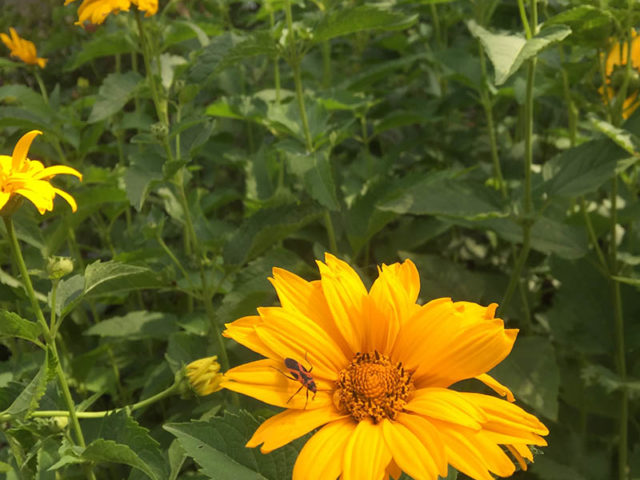‘Summer Sun’ is a long-blooming hardy perennial that produces yellow, semi-double daisy flowers with deep orange-yellow center disks all summer long. An excellent tall selection for the back of the border that looks fresh and happy even in the hottest weather, it will attract pollinators like crazy. Great for cutting.
‘Sunstruck’ grows with striking variegated foliage. A most attractive border plant even when not in flower. Covered with the same cheery, bright yellow daisies from summer thru fall.
According to Illinois Wildflowers –
The nectar and pollen of the flowerheads attract a wide variety of insects, including honeybees, bumblebees, little carpenter bees (Ceratina spp.), digger bees (Melissodes spp.), cuckoo bees (Coelioxys spp., Triepeolus spp.), leaf-cutting bees (Megachile spp.), Halictid bees (Agapostemon spp., Lasioglossum spp.), Andrenid bees (Andrena spp., Heterosarus spp.), thread-waisted wasps (Ammophila spp.) and other wasps, Syrphid flies (Eristalis spp., Toxomerus spp.), bee flies (Exoprosopa spp.), the Goldenrod Soldier Beetle (Chauliognathus pennsylanicus) and other beetles, Painted Lady butterflies (Vanessa spp.) and other butterflies, and skippers (Robertson, 1929). These floral visitors cross-pollinate the flowerheads.
Other insects feed on the leaves, stems, seeds, and other parts of False Sunflower. These species include a leaf beetle (Physonota helianthi), leaf-mining larvae of a Tischeriid moth (Astrotischeria heliopsisella), stem-boring larvae of the Rigid Sunflower Borer Moth (Papaipema rigida), floret- and seed-eating larvae of a fly (Melanagromyza virens), and a seed bug (Lygaeus turcicus); see Clark et al. (2004), Microleps website (2010), Covell (1984/2005), Marcovitch (1916), and Hoffman (1996).
Little is known about this plant’s relationships to vertebrate animals, but they are probably similar to those of sunflowers (Helianthus spp.).



